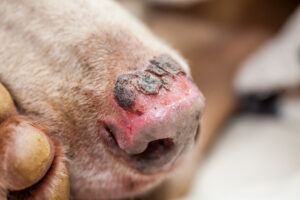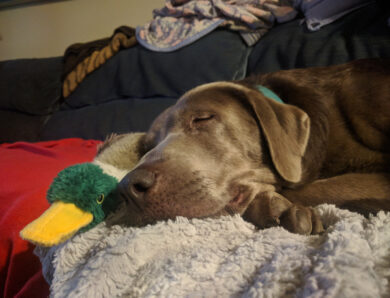
Can Dogs Get Sunburn?
In a word, yes. Not only can dogs get sunburn, but continuous exposure can lead to more serious problems. As in humans, certain types of skin cancer are often preceded by frequent sunburn.
Sunburn can also aggravate skin conditions like dermatitis or lead to infections in dogs with autoimmune disorders or that have had recent surgery.
Most sunburn in dogs is mild and goes away within a couple of days. The best protection for your dog is prevention. Here’s everything you need to know about dog sunburn including how to spot it and treat it, and what to do to prevent it in the first place.
Dog Sunburn Symptoms
- Dry, cracked skin
- Excessive scratching
- Whimpering
- Red, blistered skin
Spotting sunburn on a dog is a bit more complicated that it is with people. No lobster red patches or t-shirt lines as telltale giveaways on your pooch. Instead, you’ll want to look for dry, cracked skin. Look closely around the edges of the ears and eyes, and near his nose.
Dogs with sunburn will often scratch behind their ears, on their bellies and groin or paw at their eyes. They’ll whimper if you try to touch them there. Some dogs even get a fever if the sunburn is bad enough.
How to Treat Dog Sunburn

If your dog has a mild case of sunburn, a simple cold compress applied to his skin will help alleviate the discomfort. An aloe vera gel can also relieve pain and itchiness, and will help the burn heal more quickly. And, it’s totally safe if your dog licks at it. Witch hazel gels work well also.
Also, make sure your dog is drinking plenty of water; sunburn is a terrible dehydrator.
More severe cases may require a vet, especially if the skin is blistered. Burned skin gets infected easily so your vet may want to give your dog an antibiotic.
Planning on spending time with your pup by your backyard pool? Here is everything you need to know about dog pool safety basics.
Dogs at Highest Risk for Sunburn
All dogs can get sunburn but hairless breeds or those with white or thin fur are the most prone to it. In particular, you’ll want to be extra vigilant if you’ve got a Chinese crested, Dalmatian, greyhound, Weimaraner or whippet. Other dogs prone to sunburn include American Staffordshire terriers, boxers, and white German shepherds.
Some dogs, like collies and bulldogs, might have dark fur but also have light-pigmented noses, ears or eyelids, which will burn if exposed to the sun for too long.
In general, ears and noses are susceptible to sun damage, even if a dog’s skin or fur is dark.
Regardless of breed, all dogs have delicate skin on their bellies, where they generally have less fur to protect them. Keep an eye out if you have a dog that likes to sleep on his back, stomach exposed.
How to Protect Your Dog from Sunburn
- Don’t shave their fur
- Provide shade
- Take early/late walks
- Use sunblock
- Purchase UV-Protective Clothing
First and foremost, if you plan on spending a lot of time outdoors with your dog, do not get your dog’s fur shaved. Though less fur may keep your pooch cooler, it also exposes him to greater risk from the sun.
Instead, bring an umbrella to the beach or pick out a shady tree at the park to picnic under. Have an outdoor deck or backyard patio? Make sure you’ve got shade built in or invest in an oversized umbrella. Your dog will naturally seek the shade out when she needs a break from the sun’s rays.
Make sure you’ve always got plenty of fresh drinking water. If its hot enough for your dog to get a sunburn, then it’s also hot enough for heat stroke to be a danger. Enforce regular breaks in the shade, especially during the hours of 11 a.m. and 3 p.m.
Even if the only time you’re spending out of doors is for daily walks, try to go out in the early morning or late evening to avoid the sun when its at its hottest.

Using Dog Sunscreen
One of the best ways to protect your pup from sun damage is to use sunscreen. But not just any sunscreen!
While you can buy sunscreen designed specifically for dogs, you can use select over-the-counter brands as well. Only use brands that have no zinc oxide or para-aminobenzoic acid (PABA), as these are toxic to dogs if ingested. Most child-safe sunblock is free of these ingredients, and you’ll want one with an SPF of 30 to 50.
Apply the sunblock to the tips of your pup’s ear and along his earflaps, as well as to the top of his nose, his belly, arm pits, and groin area. If he’s got any other bare patches, apply it there as well. Keep an eye on your dog for the next 10 to 15 minutes and stop him from licking the sunscreen off. It takes time to be absorbed into the skin.
Reapply throughout the day (every four to six hours), and definitely after your dog has been swimming or squirming around in the grass or sand.
Check out the best dog life jackets on the market, if you plan on taking your pup to the beach or out boating.
Dog UV Protection Clothing
An alternative to sunscreen is UV clothing designed specifically for dogs. Though it won’t protect the ear, eyes, and nose, a dog UV shirt will protect her vulnerable belly, groin, armpits. And unlike, sunscreen, they can’t rub or wash it off. (You can buy UV-repellent doggie hats, like this adorable one with turtles on it.)
Plus, every dog in a UV-protective sun shirt is adorable!





